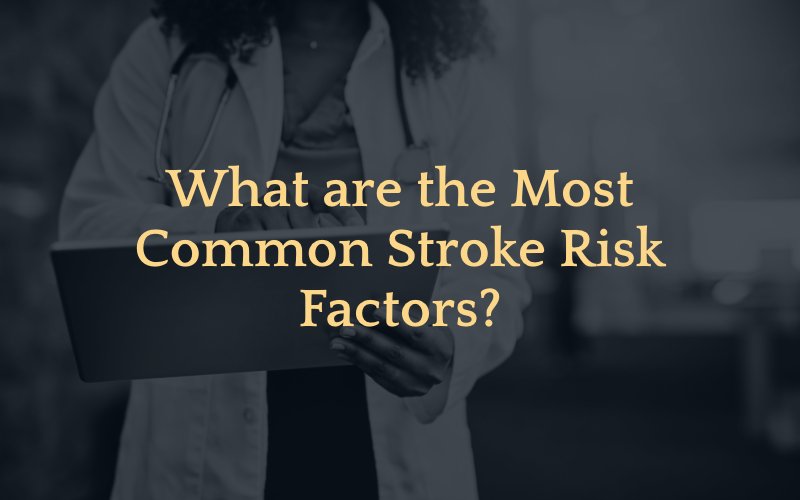No recovery • no fee
480.991.7677
scottsdale • phoenix
What Are the Most Common Stroke Risk Factors?
Published on January 26, 2024
A stroke is an emergency situation with potentially life-altering or deadly effects. A stroke causes a cut-off of oxygen to the brain or a portion of the brain either by blockage or bleeding, resulting in the death of brain cells. The brain needs a continual supply of nutrients and oxygen-carrying blood to function properly. When the blood supply to the brain is interrupted, cell death occurs in the portion of the brain affected, directly impacting body function controlled by that part of the brain.
Anyone can experience a stroke, regardless of their age but certain risk factors can increase the chances of a stroke. Identifying and understanding your risks can help you address them and potentially reduce the chances of experiencing a life-altering stroke.

What Are the Two Types of Strokes?
Medical providers divide strokes into two categories: Ischemic strokes and hemorrhagic strokes. An ischemic stroke occurs when a blood clot or piece of the arterial plaque that commonly builds up in arteries over time breaks away and moves through the bloodstream, lodging into a blood vessel supplying blood to the brain. Ischemic strokes make up about 87% of strokes. Some ischemic strokes occur from a clot originating in the brain, or a thrombosis. When a stroke occurs from a clot originating elsewhere in the body that then migrates to the brain, the clot is called an embolism.
Hemorrhagic strokes occur due to bleeding in the brain, often from a burst vessel or an aneurysm. Brain bleeds may also occur when high blood pressure causes a vessel to burst, or from bleeding stemming from a tangle of malformed blood vessels known as arteriovenous malformation. The bleeding may come from a broken blood vessel within the brain (intracranial hemorrhage). Some bleeds occur between the brain and its surrounding protective membrane (subarachnoid hemorrhage). When blood leaks into the brain from the broken vessel, it causes pressure and swelling which damages brain cells in the area.
Common Risk Factors for Strokes
Medical research shows that up to 92% of all strokes result from controllable risk factors such as the following:
- High blood pressure
- Obesity
- Smoking
- Poor diet
- A sedentary lifestyle or physical inactivity
- High cholesterol
- Coronary heart disease
- Diabetes
- Heart valve disease
- Atrial fibrillation
- Carotid artery disease
- Use of blood-thinning medications
The above are the most common risk factors for stroke. Coronary (heart) diseases such as valve problems, atrial fibrillation, coronary artery disease, and high cholesterol more commonly cause blood clots and ischemic strokes, while high blood pressure and the use of blood thinners more commonly cause hemorrhagic strokes.
Additional Risk Factors Contributing to Strokes
Some risk factors for strokes stem from other factors such as genetics, environment, and lifestyle choices. The following examples detail how these additional risk factors can contribute to a higher chance of suffering a stroke:
- Genetics: If family members have experienced strokes, it puts you at a higher risk of stroke due to undetermined genetic factors. The risk increases for those with family members who experienced strokes at a younger age. People with type AB blood seem to have a higher instance of strokes compared to other blood types.
- Age: senior citizens and the elderly are at a higher risk of strokes, as are infants under age one—particularly premature infants. Black children suffering from sickle cell disease are at an increased risk of stroke.
- High-stress levels: high levels of stress, working long hours, and experiencing anxiety and/or depression increase the chance of a stroke.
- Air pollution: those who live or work in areas with high levels of air pollution tend to have higher instances of stroke.
- Negative lifestyle choices: smoking, heavily drinking alcohol, using illegal drugs, and sleeping too much (over nine hours) all increase the risk of a stroke.
- Ethnicity and race: Black, Hispanic, Native Americans, and Alaska natives all face a greater risk of strokes than white Americans.
- Sex: Women have an overall greater risk of stroke than men due to a longer typical life span; however, at younger ages, men have a higher risk of stroke. Women who use birth control or hormone replacement therapy face a higher risk of stroke. During pregnancy and in the days after giving birth, women have a higher risk of stroke, particularly women who experience preeclampsia. Women who had preeclampsia during pregnancy also have a higher risk of stroke later in life.
- Medical conditions: some medical conditions such as Lupus and rheumatoid arthritis as well as certain viral infections increase the risk of a stroke due to inflammation.
- Medical history: Individuals with a history of transient ischemic attacks (TIA), or mini-strokes or with a history of a previous stroke are at a greater risk of a stroke.
Finally, strokes more commonly occur during extreme weather conditions like extreme cold or high heat.
Know the Symptoms of Stroke
It’s important to know the signs of a stroke in yourself or to recognize a stroke in someone else. A stroke is a life-threatening emergency and requires immediate emergency medical attention. Signs of a stroke could be any or all of the following:
- Weakness and numbness on one side of the face or body
- Difficulty speaking
- Difficulty understanding other’s speech
- Vision problems, including loss of vision or dimness in one or both eyes
- Problems with walking or movement
- Severe sudden headache
- Seizure
- Fainting
- Nausea/vomiting
Seeking medical help immediately is critical to minimize the damaging long-term effects of a stroke.
Failure to Diagnose a Stroke
Sometimes doctors fail to accurately diagnose a stroke or make a misdiagnosis. When medical providers fail to promptly and accurately diagnose a stroke, the patient doesn’t receive the critical care that they need to minimize the damage to the brain. A misdiagnosis or failure to properly diagnose a stroke can cause death or life-long disability. A Phoenix missed diagnosis attorney can help navigate your right to compensation.
Failing to diagnose a stroke leaves a medical provider or the facility they work for liable for damages to the victim through a medical malpractice lawsuit. If the stroke victim dies due to misdiagnoses, a wrongful death lawsuit recovers damages to the victim’s close surviving family members.
Let us tell your story
we care, and we can help. Contact us 480-991-7677 or fill out the form below
The personal injury attorneys in Phoenix, Arizona, at Knapp & Roberts have the compassion and trial lawyer skills to tell your story to a jury. We will get to know you and your family so that we can help the jury understand what has happened to you and your family and how it has changed your lives. Obtain the compensation necessary for the injuries and losses you have suffered.
Bob L. - "Mr. Knapp helped me with decisions I did not know how to deal with until he gave me excellent legal and medical consultation."

